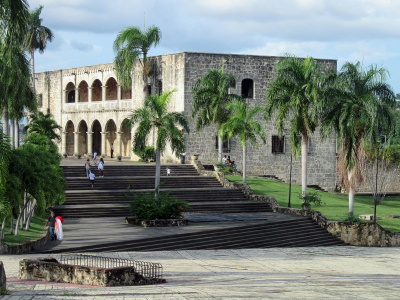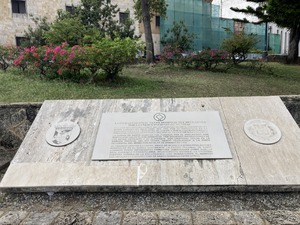Santo Domingo

The Colonial City of Santo Domingo was an early colonial settlement in the New World, that strongly influenced the development of other cities in the Americas.
Santo Domingo was founded in 1498, and its monumental buildings include the Western Hemisphere's first cathedral, its first monastery, its first hospital, its first university, and its first court of law. The city is laid out in a grid pattern adapted to the geographical circumstances.
Community Perspective: The Colonial Zone is not very big, and can easily be explored on foot. The star attraction is the well-preserved Cathedral of Santa Maria la Menor, and the Parque Colón, a beautiful tree-covered plaza, also comes recommended.

Map of Santo Domingo
Community Reviews
Els Slots

I hadn’t planned on doing a review for Santo Domingo, but after my visit in February 2024, there are two things I’d like to highlight.
The first is the widespread restoration works. Several beautification projects are going on at the same time, causing monumental facades to be covered, the Calle Las Damas broken up for street repairs and the Ozama fort to be closed. I don’t know when it all will be finished, but given the scale of it I’d say it will last at least til the end of 2024 (they started early 2023). A visit is still worthwhile, but the Cathedral is about the only place you will be allowed to enter. The colonial center ( "a diamond that needs polishing") was already upgraded as a whole in 2017 and looks quite neat and safe already.
Also, I was surprised by the wide range of ratings this site got from our community members: from 0.5 – 5 stars, with Zoë (1 star) and Solivagant (2 stars) aiming particularly low. One of the reviewers described it as “somewhat lacklustre”. So for some (particularly those who have seen a lot of Spanish colonial cities already) Santo Domingo is hard to love. I returned more positive: the site is unparalleled for its public buildings going back to the early days of Spanish colonization of the Americas. Similar sites such as Leon Viejo and Panama Viejo are now fully ruined, while Santo Domingo developed into the major city it still is and has incorporated and transformed many of those early constructions. The Cathedral with its (for the Americas) unique gothic design, original 16th-century pieces of art and Plateresque portal (pictured) is the star attraction.
I think I can see where the “lacklustre” comes from, as the city is fairly slow-paced and more ‘Dominican’ than ‘international touristy’ in its manner. Most buildings in the colonial zone are regular houses and shops for locals, and often they are newish constructions from the 19th and 20th centuries. But let’s be happy that it is not grossly over-commercialized and nobody has felt the need to introduce foreigner pricing yet.
Read more from Els Slots here.
Jay T

One of the best parts about travel is learning history from other perspectives. In US history books, Sir Francis Drake is generally viewed favorably for his role as an explorer and a privateer for the Crown; in the Spanish-speaking world, however, he was seen as a pirate and a scourge, raiding Spanish galleons, sacking towns, and ultimately defeating the Spanish Armada. This viewpoint was abundantly clear in the Museum of the Royal Houses when I visited Santo Domingo last October, and for good reason: in 1586 Drake captured the city and set a ransom to be paid by Spain. As an added incentive, Drake began demolishing and setting fire to parts of Santo Domingo until the ransom was ultimately paid. When Drake departed, one-third of the first seat of Spanish rule in the New World--not to mention the oldest continuously inhabited European settlement in the Americas--lay in ruins. Nevertheless, the city recuperated, and historic buildings can still be found throughout the Colonial City of Santo Domingo.
The heart of the colonial city would have to be Parque Colón, a beautiful tree-covered plaza that was full of music and activity throughout the weekend of my visit. The square is surrounded by civic buildings such as City Hall; hotels and restuarants housed in historic buildings; and one of the must-see sights in the city, the Cathedral of Santa María la Menor, which is the oldest cathedral in the Western Hemisphere. Audioguide tours provide an excellent overview of the cathedral, which has beauty in its simplicity.
To the east, along the Ozama River, lie the remains of the city walls, most impressively seen at the Ozama Fortress (the oldest fortress in the Americas). The view from the fortress is not particularly memorable, since the Ozama River was industrialized over the past century, but there are tour guides and information boards available to give context to the history of the fortress. Further up the river, more city walls can be seen along the Museum of the Royal Houses (housed in the former Palace of the Viceroy of Santo Domingo), and an old city gate can be seen below the Alcázar de Colón, the first fortified Spanish palace in the Americas, and the former home to Christopher Columbus' son Diego, as well as Diego's family (the palace is now also a museum).
The Colonial Zone of Santo Domingo is compact, but it has an amazing amount of history. This history includes the ruins of the first hospital in the Americas, the Hospital San Nicolás de Bari, and, following the colorful houses along Calle Hostos uphill, the ruins of the first monastery in the New World, the Monastery of San Francisco. On Sunday evenings, the monastery is often used by local Dominicans for dances, however there were no dances the evening I visited, and I couldn't find out whether this was due to Covid restrictions. One of the spots I enjoyed most in the colonial zone was the Quinta Dominica, an art museum with a beautiful secluded garden that used to be part of the Dominican convent.
There are echoes of more modern history and culture in the Colonial Zone as well. The National Pantheon is located in a former Jesuit church near the Museum of the Royal Houses, and is the resting place for notable Dominicans. At the west end of the main pedestrian street through the Colonial Zone lies an old city gate as well as Independence Park, which includes statues and a mausoleum for the founding fathers of the Dominican Republic. Outside of history, there are plenty of museums throughout the colonial zone, where visitors can learn more about Dominican products like chocolate or rum. To bring this review full circle, the tourist attraction that surprised me most with how much I enjoyed it was the 4D Cinema that gave an amusing overview of Sir Francis Drake's attack on Santo Domingo. The colonial zone of Santo Domingo is has enough attractions that I would consider it worthy of at least one full day, if not more, to fully appreciate it.
Logistics: The Colonial City of Santo Domingo is very easily traversed on foot.
Klaus Freisinger

Santo Domingo's place in history is assured by being the oldest European town in the New World, founded in 1498 by Bartolomeo Colón, brother of Christopher Columbus. It was built according to the classic Spanish town plan (a central Plaza de Armas and streets crossing in right angles) that became a model for almost all cities in Latin America, and is home to the oldest cathedral, castle, monastery, fortress, university (and many other firsts) in the New World. Its position as the capital for all the Spanish domains did not last very long, as Havana was soon found to have a more favorable position, but the city did manage to preserve the remains from its glory days quite well. The star attraction is the well-preserved Cathedral of Santa Maria la Menor, known as the Catedral Primada de América, the seat of the first Catholic diocese in the New World. It combines the expected Baroque ornamentation with Gothic features quite unusual on that side of the Atlantic. Next to the cathedral is the Parque Colón, a classic Spanish town square with a statue of Columbus, and just steps away is Calle las Damas, the oldest paved street in the New World. The Colonial Zone is not very big, and can easily be explored on foot; other buildings that I found interesting were the Alcázar de Colón (the former governor's mansion built for Christopher's son Diego, first Viceroy of the Indies, today a really well done museum), the Museo de las Casas Reales (the later residence of the colonial administration, also very interesting, but quite similar to the Alcázar), the Fortaleza Ozama (the oldest fortress still standing in the Americas), and the Plaza de España, a wide square where the WH inscription can be found. There are also various other historic buildings scattered throughout the Old Town, including the former residence of Hernán Cortés, conqueror of Peru, today the seat of the French Embassy, and the ruins of San Nicolás de Bari, the oldest hospital in the New World. It is clear that the Dominican Republic has invested quite a bit of money into the Colonial Zone to lure tourists away from the beaches, and for anyone interested in history, this is a great site to visit.
Stewart ayukawa
The Colonial Area of Santo Domingo is small, pedestrian and worth a couple of hours and then lunch. It's somewhat lacklustre despite its historical significance. Havana is much more impressive.
Philip T.K.

Santo Domingo is a beautiful place. I went there on a day trip from Puerto Plata. The cathedral is pretty breaktaking and it's considered to be the first cathedral in the new world. While in Santo Domingo, I also visited El Alcázar de Colòn, which is an old restored house that belonged to Diego Columbus. I did not have time to visit the lighthouse where Christopher Columbus is buried however. Overall, Santo Domingo was well worth spending a day away from the beach.
Community Rating
- : Inigo Cia Maxine Eisenberg Joaofg KentishTownRocks Geographybuff
- : Minkegirl Christoph
- : Klaus Freisinger Joyce van Soest Anne MoPython Julia.meyers22 Fmaiolo@yahoo.com
- : Philipp Peterer Thibault Magnien Jay T Merveil Sophie Adrian Turtschi
- : Els Slots Gary Arndt João Aender Alexander Barabanov Kasper Rudegirl Ctravel John GeorgeIng61
- : Mikko Jacob Choi Campmany
- : Solivagant Atila Ege Jon Opol Linz
- : Zoë Sheng
- : Stanimir
Site Info
- Full Name
- Colonial City of Santo Domingo
- Unesco ID
- 526
- Country
- Dominican Republic
- Inscribed
- 1990
- Type
- Cultural
- Criteria
-
2 4 6
- Categories
- Urban landscape - Colonial
- Link
- By ID
Site History
1990 Deferred
Better Info required
1990 Revision
Original proposal also included La Isabela and Concepcion de la Vega, now both separately on T List
1990 Inscribed
Site Links
Connections
The site has 28 connections
Art and Architecture
Constructions
Damaged
Geography
Human Activity
Individual People
Religion and Belief
Science and Technology
Timeline
Trivia
Visiting conditions
WHS on Other Lists
World Heritage Process
Visitors
167 Community Members have visited.
The Plaque
 (photo by Els)
(photo by Els)